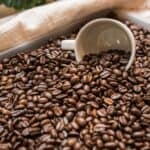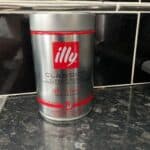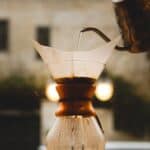5 Coffee Bean Varieties Explained
Table of Contents
Toggle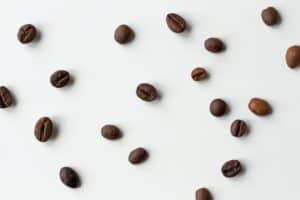
If you love a good cup of coffee you probably enjoy the smell of freshly ground coffee beans in the morning. But, what you may not be aware of is that there are actually 5 coffee bean types to choose from! You may already be aware of coffee beans have different origins and are roasted to a light, medium or dark color. But, if you have ever wondered what the 5 different types of coffee beans are actually like, you’ve come to the right place!
There are 5 main types of coffee beans. In order of global popularity, these are Arabica, Robusta, Liberica, Excelsa, and Racemosa. Arabica beans offer that classic, earthy coffee flavor, whereas Robusta beans are very bold and contain the most caffeine. Liberica and Excelsa are more niche and taste more floral or fruity, whilst Racemosa beans are very rare and have a unique, refreshing taste.
The 5 Types of Coffee Bean
First of all, you may be wondering what a coffee bean actually is and where it comes from. The beans themselves are actually seeds from the berries of the Coffea plant. There are actually a few different species of coffea, which is where we get the different species of coffee beans from.
Most people will have heard of the popular Arabica Bean, but there are also Robusta, Excelsia, and Liberica beans that are in circulation that have their own unique characteristics and flavor profiles.
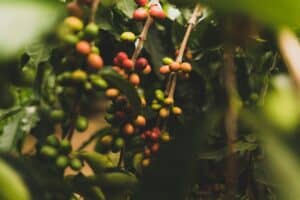
1. Arabica
Around 60% of the world’s coffee beans are of the Arabica variety. This just goes to show how sought-after they are, and for good reason! These were the beans that were first discovered and cultivated in the Ethiopian Peninsula back in the early 1400s and have clearly stood the test of time as they are still extremely popular today!
Arabica beans have a milder taste compared to the other bean types and are more susceptible to taking on flavors from other sources. They have a more subtle flavor than Robusta beans for example, owing to their less bitter taste and lower density. The main characteristic that separates the Arabica bean from others is its distinct lack of bitterness. Of course, a dark roast will bring out some bitterness in the bean, but this is still significantly less pronounced than in a Robusta bean for example.
Whilst Arabica beans are highly popular and clearly carry a great flavor, they aren’t particularly easy to cultivate. They require high altitude, shade, and a steady flow of rainfall, conditions that can sometimes be hard to come by in the tropics. There are only certain climates that are naturally conducive to these conditions and also possess the nutrient-rich soil needed to cultivate the highest quality of coffee cherries, so it can be resource intensive to replicate these conditions in areas where they do not naturally occur.
However, the reward can be well worth the effort, as Arabica beans fetch a very high price in the coffee trade, thanks to their incredibly high demand. Coffee manufacturers can charge high prices in order to cover their expensive production costs, but wholesalers and premium coffee brands will happily pay these prices and pass them on to the consumer who ultimately will be willing to pay top dollar for the best coffee.
Arabica Coffee originates from the flowering Coffea Arabica plant, a subspecies of the Rubiaceae plant. Most artisan and specialty coffee houses will boast about their 100% Arabica coffee bean blends, signifying the high-quality nature of their stock. So, if you are buying coffee for yourself in your grocery store or online, look out for the blend type to ensure that your high-grade Arabica coffee has not been combined with a cheaper, lower-quality alternative such as Robusta.
2. Robusta
Robusta coffee beans are the second most popular variety, making up around 35% of global consumption. They are less expensive to produce and are often included in mass-produced blends for cheaper coffee.
Where Arabica beans have a reasonably mild taste that can vary massively depending on the origin, roast type, and surrounding habitat, Robusta beans have a much more uniform flavor. They are characterized by their bitterness which resembles a ‘burnt’ taste.
Robusta beans have a much higher caffeine content than Arabica beans. Where Arabica beans consist of between 0.7% and 1.5% caffeine, Robusta beans contain between 1.7% and 4% caffeine! So, if you can handle the taste there is only one choice if you are after a proper wake-up call in the morning!
Whilst many high-end and even mainstream coffee brands will shy away from Robusta beans as they are often labeled as cheap or low quality, they are definitely worth a try. As the coffee industry has grown, there have been more and more roasters and producers bringing us wider varieties of coffee from different beans. You can now get Robusta beans that have been cultivated and produced in such a way that their bitterness is significantly dialed out and you can pick up more earthy or spiced notes.
Robusta coffee comes from the Coffea canephora plant.
Robusta beans tend to be grown in Indonesia and Africa, so look out for origins in these countries if you are after some of these little pocket rockets!
3. Liberica
Another major but less known variety of coffee beans is the Liberica. Unsurprisingly, they originate from Liberia, hence the name, and are one of the rarest coffee bean varieties. Making up just 2% of the world’s coffee consumption, Liberica coffee beans are primarily grown in Malaysia, accounting for over 90% of their coffee production.
Liberica coffee beans come from the Coffea Liberica plant which is the tallest of the coffee-related Rubiaceae family. Liberica beans are uniquely oblong and tend to be asymmetrical in shape.
In terms of taste, Liberica beans are more closely related to Robusta than Arabica, as they possess earthy and slightly bitter notes. The taste resembles aniseed, which means Liberica coffee definitely has an acquired taste. Among coffee experts this variety of beans is a bit like marmite, you either love it or you hate it!
If you are looking to experiment with a rare coffee bean that will either blow your head off or leave you reeling back, this is the one to go for!
4. Excelsa
Potentially the least revered coffee bean of them all is the Excelsa bean. It is actually classed as a subset of the Liberica bean so some coffee experts and botanists do not really recognize it as a standalone species. However, it is definitely worth celebrating as it is a unique and rare bean that is definitely worth seeking out.
Coming from the Coffea Excelsa plant, these beans account for around 6% of the world’s coffee market.
Excelsa beans have a taste that is a bit of a coffee’s greatest hits. They have floral notes and subtlety like Arabica beans, but also possess a depth of flavor and a sharp tartness reminiscent of a Robusta bean.
This unique flavor gives them an appeal that many coffee enthusiasts enjoy, however in some respects, they are considered lower quality due to the fact they are grown and processed in poorer conditions as there is such a low global demand for them. Given the same care and attention as the more popular beans, Excelsa beans could too become a highly sought-after specialty coffee.
5. Racemosa
A practically unheard-of variety of coffee beans that prides itself on being the rarest of them all is the Racemosa. It is a close relative of the Arabica bean and grows on the Coffea Racemosa plant, which is only able to grow in the 60-mile forest between Mozambique and Kwa-Zulu Natal in South Africa. The plant is Coffea Racemosa extremely resistant to coastal conditions, making it ideally suited to its habitat.
Racemosa isn’t a widely consumed coffee as it is a protected species. It has very low levels of caffeine so it doesn’t have the same commercial appeal as Arabica or Robusta, but it is consequently regarded as a more holistic, pure drink. If you are caffeine intolerant but still want to try a specialist, rare coffee that has not been industrially decaffeinated, this could be your best bet.
Racemosa coffee is relatively similar in taste to Arabica, although it is set apart by its refreshing flavors. It has that familiar nutty, sweet flavor we know and love but also resembles mint and licorice.
So, Which Should You Choose?

As with any coffee choice, there isn’t really such a thing as a ‘best cup of coffee’. There is only the best cup of coffee for you. There is an abundance of choices when it comes to coffee origins, roasts, manufacturers, brewing methods, and even bean species, so there is no end to the possibilities!
However, as a rough guide to point you in the right direction, if you are looking for that classic coffee taste that you will be familiar with if you have grown up drinking big-brand coffee or high-quality coffee from coffee houses, 100% Arabica beans are the way to go. They are the purest and most familiar bean type to most people and will offer a well-balanced flavor that can be used as a bit of a blank canvas for different flavor profiles to rift off of.
If you are looking for a more earthy, bitter taste then give Robusta beans a try. Not only do they have that characteristically American ‘burnt’ taste, but they also have a very high caffeine content so will give you that early morning kick you may well be craving!
Finally, if you are a well-versed coffee nut and are after something a bit different for a special occasion that may be a little on the quirky side, then seeking out Liberica, Excelsa, or Racemosa coffee beans could be well worth your while. These are more expensive than the more mainstream alternatives, but trying each of them at least once will give your pallet a new dimension and help you appreciate different coffee flavor profiles to the max.
I have included a table below to help make the comparison of coffee beans more accessible:
| Coffee Bean | Arabica | Robusta | Liberica | Excelsa | Racemosa |
| Global Consumption | ~60% | ~35% | ~2% | ~6% | ~1% |
| Flavor | Sweet, Nutty, Chocolatey | Bitter, Earthy, Burnt | Smokey, Woody, Fruity | Floral, Sour, Tart | Nutty, Licorice, Mint |
| Acidity | High | Low | Medium | Low | Low |
| Price | High | Low | Very High | Medium | Very High |
| Bean Size | Medium | Large | Large | Small | Very Small |
| Caffeine Content | 1.5% | 2.7% | 1.2% | 1.1% | 0.4% |
Summary
Good quality coffee beans are ultimately the cornerstone of enjoying an excellent coffee experience. We may get caught in the trap of only experiencing Arabica beans as they are the most widely available to most of us, but in actuality, there are many more bean types out there to try.
Whilst Arabica beans are popular for a reason, advancements in the coffee industry over the past few decades have meant that the market for alternative specialty beans is ever-growing. This is great news for the coffee enthusiast that thinks they’ve ‘seen it all’, as there is a whole new world of coffee bean discovery to explore!
Coffee Bean Varieties Frequently Asked Questions
Whilst on single coffee bean variety is tehcnically ‘better’ than another, Arabica is generally consdiered as the gold standard. This is because it has a well balanced flavour profile and is given by far the most growing, processing and industrial resources compared to any other coffee bean variety.
Robusta coffee is generally used in coffee blends to add caffiene content, bold flavours and depth. They are traditionally roasted dark, and that is what often aligns them to bold, often bitter tasting Italian roasts.
Nescafe tend to use a blend of Arabica and Robusta coffee bean varieties. They often favour primarily Arabica, with a small percentage of Robusta added for caffiene and depth of flavour.

